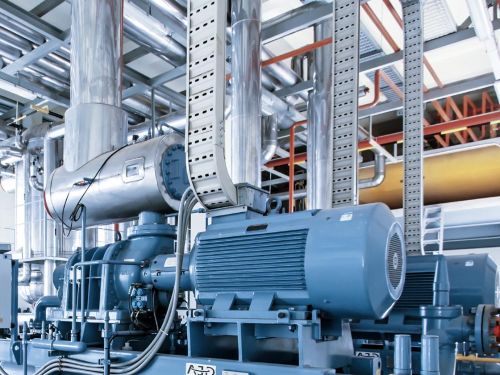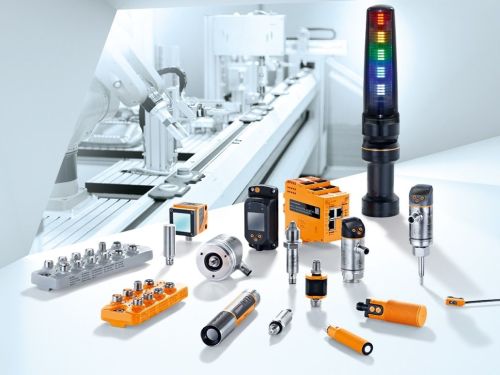Sensors ensure transparency and efficiency
HARTING relies on digitalised production processes to monitor energy use
The HARTING Technology Group is a leading global supplier of industrial connection technology. Around 6,200 employees work for the group in 44 sales companies and 15 production facilities across the globe. In addition to the aim of supplying its customers with products of the best possible quality at all times, the family-owned company is also committed to sustainability. In order to produce as efficiently as possible and minimise its environmental impact, HARTING focuses on the digitalisation of its production plants at its headquarters in Espelkamp.
“The high degree of data transparency we have achieved in our three plants enables us to take an objective look at our production processes,” says Thomas Kämper, Head of IIoT Solutions & Services at HARTING Electronics. Several hundred machines transmit their data to the IT level where it is continuously analysed by Thomas Kämper’s team.
Retrofit standard for heterogeneous machine park
Luca Manuel Steinmann, Process Data Engineer IIoT at HARTING Electronics, describes the challenges associated with implementing a central data evaluation solution: “We have very heterogeneous systems with diverse interfaces and protocols in our machine park which already provide a lot of relevant process data and information, e.g. on cycle times and downtimes. To make this information accessible for analysis at the IT level, we needed to integrate it into the data infrastructure of the OT level. We also added additional sensors, e.g. for monitoring of cooling water, compressed air and electricity consumption.”
After considering different retrofit standards for plant digitisation, HARTING quickly opted for IO-Link. IO-Link masters installed on the machine receive data from the sensors mounted at the machine location and transmit it to the IT level. This creates the information interface between the Operational Technology (OT) level, i.e. the machines, and the Information Technology (IT) level.


Picture 1: All machine data is collected and transmitted to the IT level to be analysed by HARTING’s data analysts.
Picture 2: The IO-Link master collects the data from the connected sensors and transmits it to the fieldbus and to an edge gateway.
IO-Link: one sensor, a wealth of information
“The advantages of IO-Link are evident,” says Thomas Kämper. “Thanks to this widely used open standard, we can easily connect additional sensors to further sharpen the digital machine image. Using standard interfaces such as Modbus TCP or IoT Core, we are able to collect the data in a standardised
and intuitive way.”
Another benefit: The sensors can transmit several important process values at the same time. For example, HARTING uses the SD compressed air meter from ifm to precisely monitor compressed air consumption. This sensor not only transmits the current flow values via IO-Link, but also provides other relevant data such as pressure, temperature and total quantity, which are relevant for compressed air monitoring. To give an example: For reliable operation, machines usually require an operating pressure of 6 to 6.5 bars. If this value drops, this could indicate a leak in the piping system.

Cost reduction through continuous pipe monitoring
ifm offers a comprehensive range of products for pipe sizes from DN8 to DN250 for continuous compressed air monitoring – from the compressor through to the machine – and data transmission to the IT level. This makes it possible to quickly and precisely locate and eliminate any occurring pressure loss in the piping system, which, in the long term, is much more cost-saving and effective than increasing the pressure of the compressor to compensate for pressure drops: In fact, a reduction of 1 bar in operating pressure can reduce the energy costs by up to 7%. With its IIoT platform moneo, ifm offers a software tool that automatically calculates the pressure difference, providing a quick and easy way to detect leaks, clogged filters and other issues leading to excessive compressed air consumption.

Valuable insights into the compressed air system. Clearly recognisable: Basic consumption (1) and production consumption (2) increase significantly after a leak has occurred (3). After its elimination, the basic consumption nearly drops to zero (4).

The SD compressed air meter is offered for pipe sizes from DN8 to DN 250.
Keeping an eye on the most expensive energy resource
Already at a very early stage of its digitisation journey, HARTING
focused on compressed air monitoring.
“Compressed air is one of the most expensive forms of energy in industry,” says Luca Manuel Steinmann. “Thus, it is important to closely monitor its consumption in order to identify any leaks in the compressed air system early. As compressed air is an invisible resource and leaks are difficult to detect in noisy production surroundings, we initiated the ‘leakage detection’ project.” The savings potential became quickly apparent: “Based on the transmitted data, we observed a sharp increase in compressed air consumption at one machine. As this increase was not only noticeable during production, but also in stand-by operation, it was clear that the machine required maintenance. The inspection revealed a leak in the compressed air system. The leak was repaired at the next possible opportunity, meaning the maintenance time from leak detection to repair was significantly reduced,” says Thomas Kämper.
Another benefit is the energy saved as a result. Thus, both financial and energy losses can be greatly reduced. Each machine transmits multiple measured values to the IT level.
“This is where the puzzle pieces of information come together to form a big picture, providing us with precise insights into the current health status of each machine,” says Thomas Kämper. “In combination with the camera-based production quality analysis, we can not only guarantee needs-based machine maintenance, but also consistent high production quality. The high degree of process transparency we achieve through data analysis reduces our response time, enabling more targeted maintenance planning. All of this contributes to a higher quality level and product output, while at the same time reducing scrap levels.”
AI-optimised maintenance schedules
However, the optimisation process is yet far from being completed according to Thomas Kämper and his team: The analysts are working on a data-based solution to determine the best time to fix a leak. “Immediately stopping a machine to perform maintenance is not always the most cost-effective option, as it’s not just the leak that causes financial loss, but also the machine downtime. I’m convinced that with the help of artificial intelligence, we will become more efficient in this area in the future.”

To achieve full data transparency, all machines at HARTING’s site in Espelkamp are connected to the network.
No out-of-the-box solution
The collected data not only helps HARTING with quality assurance. It also provides insights into the carbon footprint of each product manufactured at the plant in Espelkamp. “We started digitally measuring and analysing energy consumption here in production as part of the ISO 50001 certification of our energy management system in 2017. As there was no out-of-the-box solution for this application, we brought ifm on board as a partner to support us with the necessary knowledge and products. The excellent and close collaboration quickly resulted in the first digitisation projects.”
CO2 transparency - also towards the customer
The sensor information and machine data has also helped HARTING take a leap forward in meeting their target of achieving a sustainable and resource-saving production, as Thomas Kämper explains: “Since we perform every production step from raw material processing to the finished product on site, we can precisely determine the energy costs and the carbon footprint of each finished product. We also intend to pass this information on to our customers in the future to assist them in precisely determining their own carbon footprint.”
Convinced of the added value of digitisation
projects are planned to further enhance efficiency and quality assurance in production. “We intend to closely monitor other forms of energy similarly to compressed air,” says Thomas Kämper. “We also plan to centrally analyse quality assurance factors such as coolant / lubricant values in the future, e.g. by measuring conductivity.”
Precise production efficiency analysis
As more and more machines continuously transmit increasing volumes of data, entire process sequences can be compared: “The data enables us to objectively determine which machine is most effective in producing which product. By aligning our production planning accordingly, we can achieve further energy savings.”

HARTING is able to determine the energy consumption of each individual product. This is valuable information for the company - but also for its customers.
Conclusion
With the support of ifm, HARTING has taken a big step towards full data transparency at its Espelkamp site and can now manufacture its high-quality products more efficiently thanks to IT-based analysis.


